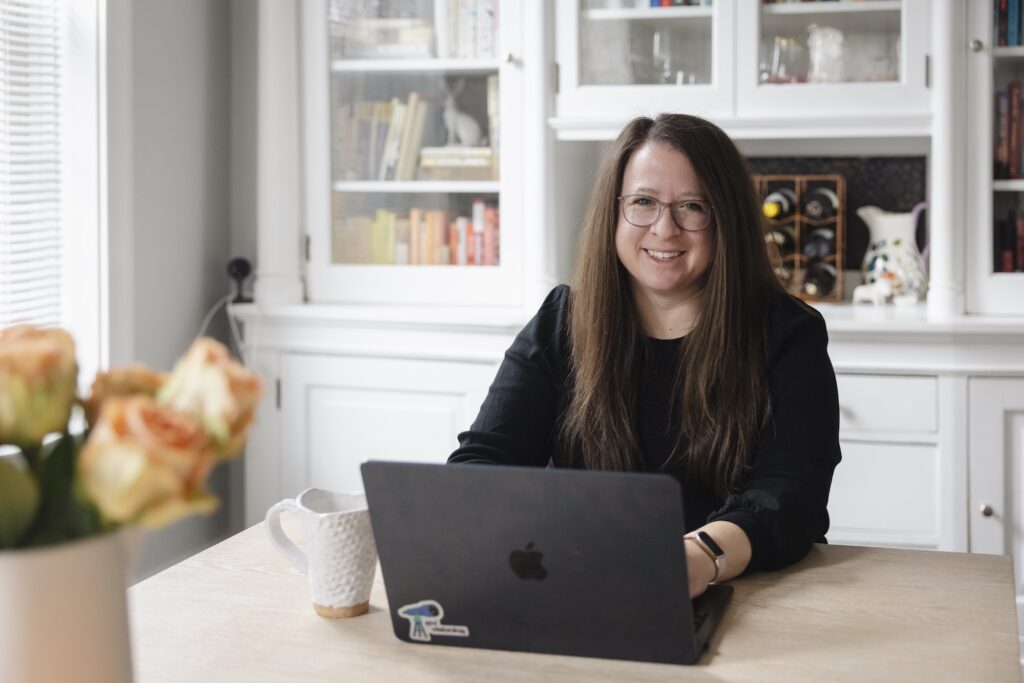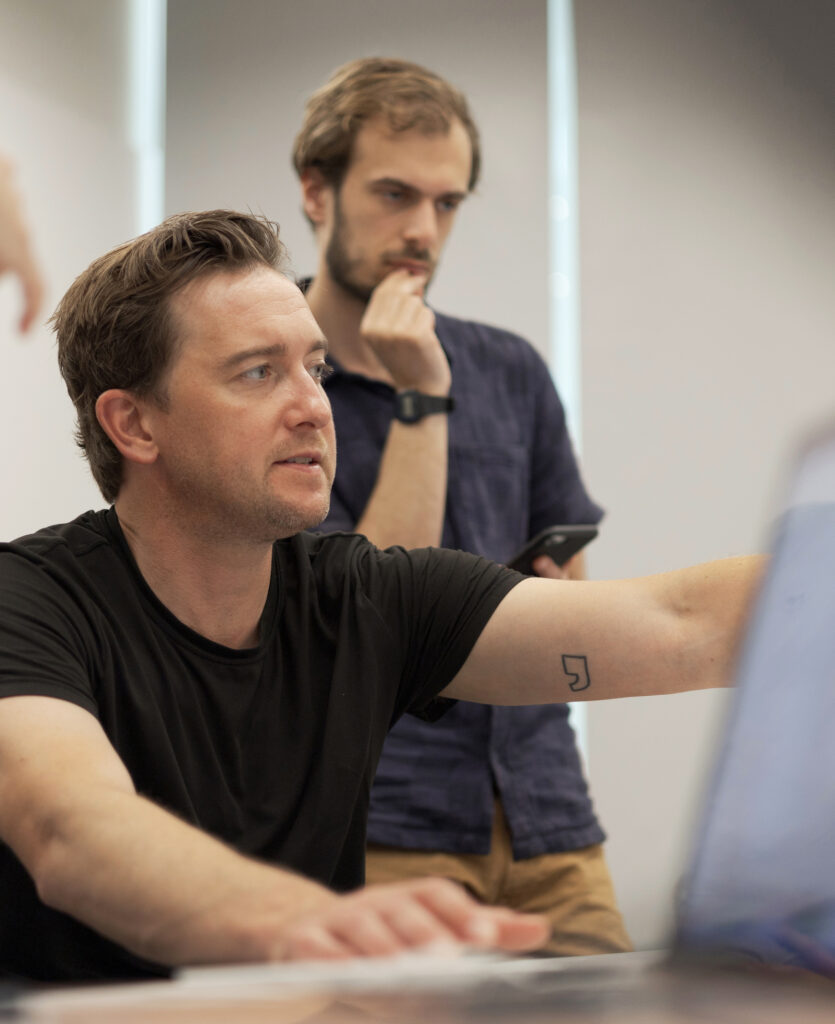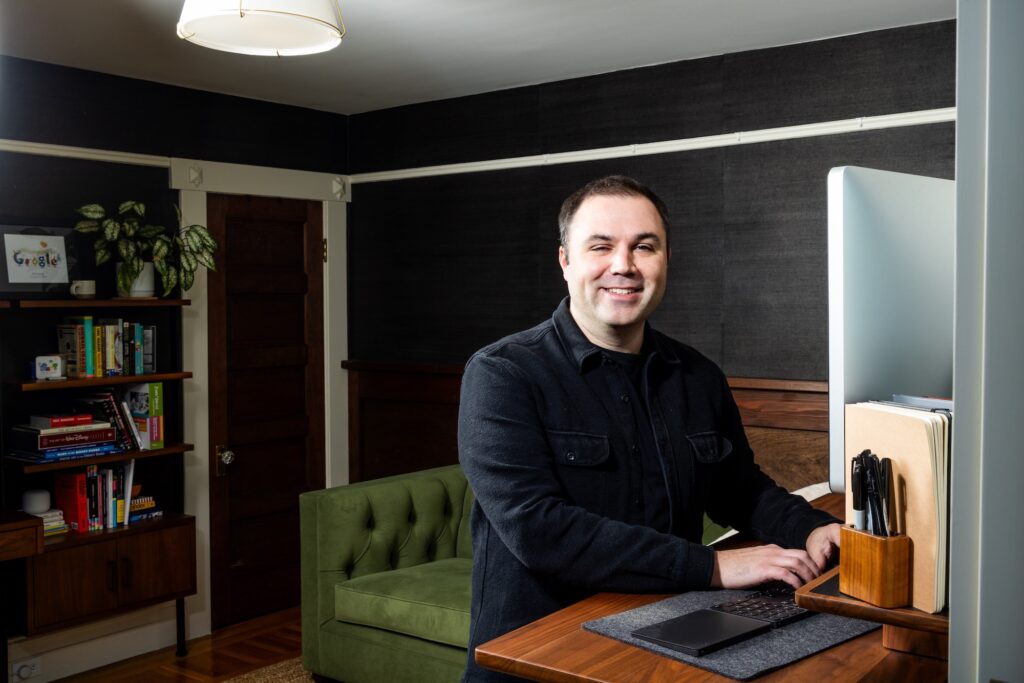“In the classroom, you are rewarded for proving that you are correct,” says Aaron Zemach. “In the lab, you’re equally rewarded for proving that you were wrong — because that lets you move on to the next thing.”
Zemach, BS ’14, MS ’15, is discussing WashU’s new Master of Design for Human-Computer Interaction and Emerging Technology (MDes). The two-year, 60-credit professional program — the first STEM-designated degree administered by the College of Art in the Sam Fox School of Design & Visual Arts — will include traditional design courses and a multiyear, lab-like studio experience. Announced last summer, the program will welcome its first cohort in the fall.
But the planning process stretches back years. And in critical ways, that planning has been shaped by a trio of alumni advisers. Like Zemach, Molly Needelman, BFA ’08, and Will Bates, BFA ’09, have spent their careers working in user experience, or UX, for some of today’s most prominent tech companies. Now all three are using their expertise to benefit the next generation of UX designers.

“The three of us often talk about how we learned to think at WashU,” says Bates, a senior staff UX manager at YouTube, where he oversees the YouTube on TV team. “It was never about using the latest tools, because the reality is in a year many of those tools will be out of date. Tech companies want people who can question, who can pose interesting provocations, and who can put together unexpected combinations.”
Needelman, a UX strategist at Google who co-founded YouTube’s GenAI Lab, nods in agreement. “The ability to think and the ability to collaborate,” she adds, “are two places where WashU really shines — and prepares its students for the future.”
Defining design
The new MDes program features connections with the McKelvey School of Engineering and Arts & Sciences. In many ways, it grew out of WashU’s popular minor in human-computer interaction, launched in 2018 by the Sam Fox School and McKelvey Engineering.
The field, variously known as UX, HCI and interaction design, dates to the 1980s. Home computing created millions of users who were neither academic researchers nor information technologists. This generated tremendous opportunity but also highlighted a gap between programming capacity and intuitive usability. In 1986, when the “MS-DOS Power User’s Guide” ran 397 pages, Apple’s Human Interface Group included just seven people.
But as smartphones, tablets and other mobile devices turbocharged the digital realm, the need for, and competitive advantages of, intuitive usability grew clear. At WashU, HCI became part of the computer science and communication design curricula. Still, their respective approaches remained rooted in disciplinary traditions.
“We all use the term ‘design,’ but it doesn’t always carry the same meaning.”
Jonathan Hanahan, associate professor in the Sam Fox School
“We all use the term ‘design,’ but it doesn’t always carry the same meaning,” says Jonathan Hanahan, associate professor in the Sam Fox School and founding chair of the new MDes program. Hanahan also co-founded the HCI minor with Caitlin Kelleher, professor of computer science and engineering at McKelvey Engineering.
“In engineering, design is about finding quantitative solutions,” Hanahan continues. “‘This is the problem; let’s go solve it.’ But in communication design, we’re focused on qualitative questions: ‘Why is this the problem? Whom is that solution for? How is it going to be experienced?’
“So in a collaborative sense, the two groups really benefit from one another,” Hanahan adds. “Can we make a solution that is efficient and effective but also easy, delightful and fun?”
Old friends
Bates and Needelman both recently served on the Sam Fox School’s Interaction Design working group, as part of its “Shaping the Future” strategic plan. They have the relaxed camaraderie of old friends and former classmates. “Molly is the reason I ended up in art school,” Bates says with a laugh.
Arriving at WashU, Bates intended to study psychology and film but by sophomore year was contemplating a switch. “So I went to talk to Molly, who was an RA in my building,” Bates says. “She was sitting cross-legged on the floor, surrounded by a series of beautiful watercolor paintings of a jazz funeral in New Orleans. And I thought, ‘You know what? I think I should go to art school.’”
In 2014, when YouTube had an opening for a UX strategist, Bates, who’d joined the company two years earlier, insisted that Needelman apply. “‘This role is made for you,’” Bates remembers telling her. “It felt very full circle.”

Like Bates, Needelman had chosen WashU for its emphasis on cross-disciplinary collaboration. “The opportunity I saw here was to be fluid amongst my interests,” she says. “I was able to study world religion and design and printmaking and children’s literature. All these things are part of me.”
Before joining YouTube, Needelman had worked in the nonprofit sector and as an independent consultant. She had also been in the inaugural class of a new dual degree program, earning both an MBA from Johns Hopkins University and a master’s in design leadership from the Maryland Institute College of Art.
“It was exciting,” she says. “I was in that first cohort, and as students, we were at the ground level. We could help to shape the future of the program.” The experience crystallized her thoughts on best practices in professional design education, readying her to provide her earlier alma mater guidance on its own new MDes program.
A hybrid field
In spring 2019, just a few months after the launch of WashU’s HCI minor, Hanahan reached out to Bates — who lives in the San Francisco Bay Area — with a request. Would Bates take a trip back to St. Louis and help review current students’ final projects?
“I had a visceral memory of presenting in that same room as a student,” Bates says. “It was surreal to be on the other side.” Longer conversations ensued: How might WashU’s growing HCI curriculum instill user-centered principles? What’s the right balance between HCI and foundational design skills?
Later that year, Needelman joined Zemach, then a UX designer and prototyper for Google Docs, Sheets and Slides, for a lecture and a series of HCI workshops with McKelvey and Sam Fox students. “It covered all the things that we’re still really passionate about,” Zemach remembers. “Talk to people. Do research. Measure impact.”
That was the first time Zemach, who is based in New York, met Needelman, who is based in Chicago. But Zemach and Bates had known one another for a few years. In 2014, as a WashU senior, Zemach interned at Google, where Bates was leading intern programming.
“I came into this career as a Sam Fox alumna with an MBA. Will came from Sam Fox with a BFA. Aaron comes from engineering. And now we’re all collaborative teammates.”
Molly Needelman, BFA ’08
Their biographies, they eventually learned, were almost comically similar. Raised in the Chicago suburb of Deerfield, Illinois, both had attended the same middle school, the same high school, the same summer camp and, of course, the same university. They’d even won some of the same awards.
“Aaron and I have lived the exact same life,” Bates quips. Zemach shoots back. “You were my role model. I just didn’t know it.”
Yet their different academic paths — Bates through Sam Fox, Zemach through McKelvey — speak to the field’s hybrid, and quickly evolving, nature. What is the right background for UX professionals? What should HCI training encompass? Indeed, when first applying to Google, Zemach worried about his portfolio.
“I was panicking!” he recalls with a laugh. “I thought the expectation was that you’d submit all the beautiful visual designs that you’d created. What I had were applications I’d built. But it’s interesting: The hiring manager went through the application pools for interaction design and for software engineering. Who had experience with both? Because that’s who they were really looking for.”
Adds Needelman: “I came into this career as a Sam Fox alumna with an MBA. Will came from Sam Fox with a BFA. Aaron comes from engineering. And now we’re all collaborative teammates.”
Superpower
Since announcing the new MDes, Hanahan has spent a lot of time on the road. He’s visited more than a dozen colleges and universities. He’s spoken with scores of prospective students. He is often asked about the ideal background for applicants.
Hanahan responds with an analogy. Imagine a neighborhood. There are a bunch of different houses. “We want people who are experts in their own backyards,” he says. “But they’re also interested in dialogue across the fence.

Jonathan Hanahan (left) will serve as chair of WashU’s new Master of Design for Human-Computer Interaction and Emerging Technology. (Photo: Audrey Westcott/WashU)
“You might have technical skills,” Hanahan continues, “but you’re never going to have all the technical skills. Learning to embrace that, learning that you don’t have to solve every problem by yourself — it’s kind of a superpower.”
That perspective is echoed in the program’s structure. Studios will focus on research, design and engineering principles. Seminars will explore the history, ethics and moral positioning of technology. One intriguing, required seminar — “What Could Go Wrong?” — will investigate social impact and the nature of unintended consequences.
But the heart of the MDes program will be what organizers have dubbed the Ix3 Studio, a collaborative, lab-like research space that, critically, will continue across all four semesters. “That continuous element is unique,” Hanahan says. “Most design programs chunk curricula into semester-based projects. But industry has taught us that you cannot develop, test and refine a solution in a single semester.
“We think of technology as fast,” Hanahan adds. “And, yes, we can do some things very fast. But working with complex systems takes time. The Ix3 Studio is where design thinking, technical skills and leadership will all get synthesized.”
The audience piece
Short for “interaction, innovation and impact,” the Ix3 Studio represents a convergence of design, engineering and business cultures. For all their differences, the fields do share many values: the importance of research, the processes of ideation and prototyping, the need for testing and clear-eyed critique.
“Design is inherently about making something in service to someone else,” Bates says. Fashion designers create clothing for others to wear, he explains. Communication designers impart information for others to consider. “Interaction design is about making a digital product that is functional, is usable and addresses the specific needs of a user. A lot of students, especially at the undergraduate level, totally skip over that audience piece.”

Needelman recalls her own senior thesis project. She created a resource book for elementary school teachers who had students with more severe cases of spina bifida. “I did a lot of work,” she says. “I learned from kids who were thriving. I interviewed doctors. From a design perspective it was clever. It was self-illustrated. It’s a project I’m still proud of.
“But I never talked to an actual elementary school teacher,” she adds ruefully. “I never had the understanding, or frankly the courage, to go out and work with them.”
Zemach nods. “That’s a big part of HCI,” he says. “If I have an idea in my head, I want to put it in front of colleagues and users as soon as possible and have them pull it apart — so that we can learn and continue to iterate.
“If we do that enough, if we go through enough cycles, eventually we get to the point where we’ve found something that’s true and useful and impactful,” Zemach adds. “And ‘failure’ — in quotes, because it’s not really failure — is just a step in the process.”
A design problem
Launching a new academic program is never a small endeavor. In a hybrid discipline involving multiple schools and departments, the to-do list is particularly daunting: Recruit faculty and students. Design curricula. Determine research parameters. Establish criteria for promotion and advancement. Secure physical space and equipment. Communicate with stakeholders. Respond to developments in the field.
“Building this program is itself a complex design problem,” Hanahan says, noting that throughout the process, Bates, Needelman and Zemach served as trusted industry advisers. “In a way, it’s an argument for why designers should be in leadership positions within complex organizations.
“Designers tackle problems through both analytical and speculative processes,” Hanahan continues. “Technology is only as valuable as its use case. If it just sits on a shelf, what’s the point? We’re building a program where design, tech, craft and criticality are all baked in from the beginning.”
Zemach, recalling his own path from computer science to HCI, makes a similar point: “I discovered that my passion wasn’t solving problems that computers were having. It was solving problems that people were having, with computers.”
“That’s the foundation of what we do,” Needelman agrees. “All the research and design, all the products that we’re working on — it’s all built on a foundation of responsibility.
“There are so many possible futures we could be walking into,” she adds. “How do you, as a designer, understand the human implications? How do you understand the social, technological, economic, environmental and ethical implications? Design is all of that.”
“I do a lot of hiring for my team,” Bates says. “I’m always looking for that nontraditional background. I want people who can demonstrate a depth of self. What are you really interested in? What are you passionate about? Can you think through the bigger picture? I’m always going to be drawn to candidates who can demonstrate their thought processes over those who only show that they can make something pixel-perfect.
“One of the reasons I love the MDes program is that it doubles down on the strengths of WashU,” Bates concludes. “Let’s get people who are passionate about ideas and concepts, who have their own interests and their own ways of combining things — and let’s go make something real.”


